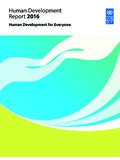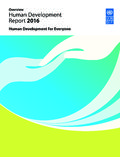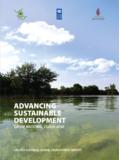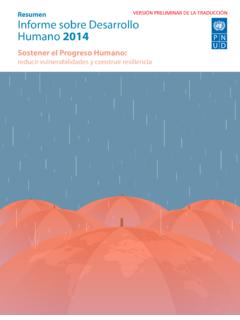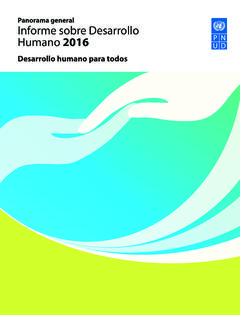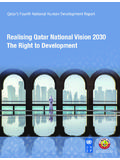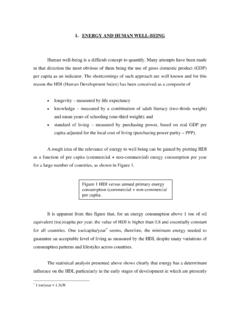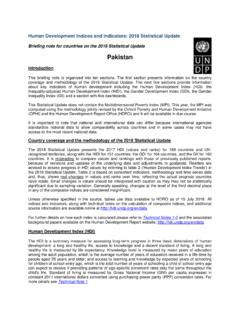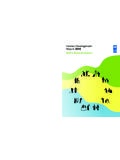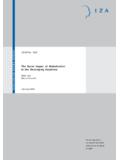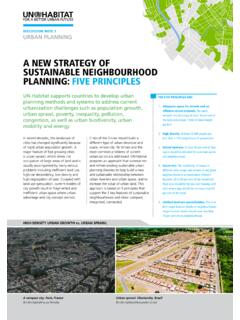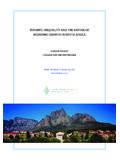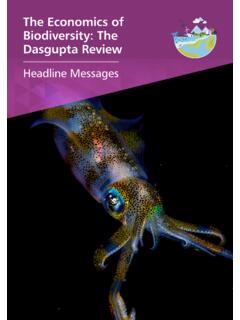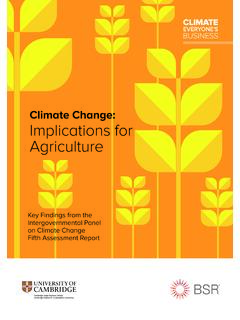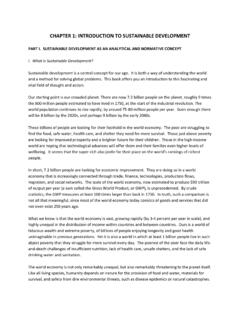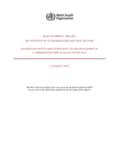Transcription of Human Development Report 2019
1 Human Development Report 2019 Beyond income, beyond averages, beyond today:Inequalities in Human Development in the 21st centuryEmpowered lives. Resilient 2019 | Beyond income, beyond averages, beyond today: Inequalities in Human Development in the 21st centuryCopyright @ 2019 By the United Nations Development Programme 1 UN Plaza, New York, NY 10017 USA All rights reserved. No part of this publication may be reproduced, stored in a retrieval system or transmitted, in any form or by means, electronic, mechanical, photocopying, recording or otherwise, without prior permission. Sales no.: ISBN: 978-92-1-126439-5 eISBN: 978-92-1-004496-7 Print ISSN: 0969-4501eISSN: 2412-3129A catalogue record for this book is available from the British Library and Library of Congress General disclaimers. The designations employed and the presentation of the material in this publication do not imply the expression of any opinion whatsoever on the part of the Human Development Report Office (HDRO) of the United Nations Development Programme (UNDP) concerning the legal status of any country, territory, city or area or of its authorities, or concerning the delimitation of its frontiers or boundaries.
2 Dotted and dashed lines on maps represent approximate border lines for which there may not yet be full agreement. The findings, analysis, and recommendations of this Report , as with previous Reports, do not represent the official position of the UNDP or of any of the UN Member States that are part of its Executive Board. They are also not necessarily endorsed by those mentioned in the acknowledgments or mention of specific companies does not imply that they are endorsed or recommended by UNDP in preference to others of a similar nature that are not mentioned. Where indicated, some figures in the analytical part of the Report were estimated by the HDRO or other contributors and are not necessarily the official statistics of the concerned country, area or territory, which may be based on alternative methods. All the figures used to calculate the Human Development composite indices are from official sources. All reasonable precautions have been taken by the HDRO to verify the information contained in this publication.
3 However, the published material is being distributed without warranty of any kind, either expressed or implied. The responsibility for the interpretation and use of the material lies with the reader. In no event shall the HDRO and UNDP be liable for damages arising from its in the USA, by AGS, an RR Donnelley Company, on Forest Stewardship Council certified and elemental chlorine-free papers. Printed using vegetable-based 2019 Human Development Report is the latest in the series of global Human Development Reports published by the United Nations Development Programme (UNDP) since 1990 as independent, analytically and empirically grounded discussions of major Development issues, trends and policies. Additional resources related to the 2019 Human Development Report can be found online at , including digital versions and translations of the Report and the overview in more than 10 languages, an interactive web version of the Report , a set of background papers and think pieces commissioned for the Report , interactive data visualizations and databases of Human Development indicators, full explanations of the sources and methodologies used in the Report s composite indices, country profiles and other background materials as well as previous global, regional and national Human Development Reports.
4 Cor-rections and addenda are also available cover conveys the inequalities in Human Development of a changing world. The dots in different colors represent the com-plex and multidimensional nature of these inequalities. The shad-ow of the climate crisis and sweeping technological change, evoked by the color of the cover background that suggests heat, will shape progress in Human Development in the 21st Development Report 2019 Beyond income, beyond averages, beyond today:Inequalities in Human Development in the 21st centuryEmpowered lives. Resilient nations. Published for theUnited NationsDevelopmentProgramme(UNDP) Human Development Report 2019 TeamDirector and lead authorPedro Concei oResearch and statisticsJacob Assa, Cecilia Calderon, George Ronald Gray, Nergis Gulasan, Yu-Chieh Hsu, Milorad Kovacevic, Christina Lengfelder, Brian Lutz, Tanni Mukhopadhyay, Shivani Nayyar, Thangavel Palanivel, Carolina Rivera and Heriberto TapiaProduction, communications, operationsBotagoz Abdreyeva, Oscar Bernal, Andrea Davis, Rezarta Godo, Jon Hall, Seockhwan Bryce Hwang, Admir Jahic, Fe Juarez Shanahan, Sarantuya Mend, Anna Ortubia, Yumna Rathore, Dharshani Seneviratne, Elodie Turchi and Nu Nu WinExternal contributorsChapter 3 (by the World Inequality Lab): Lucas Chancel, Denis Cogneau, Amory Gethin, Alix Myczkowski and Thomas PikettyBoxes and spotlights.
5 Elizabeth Anderson, Michelle Bachelet, Bas van Bavel, David Coady, James Foster, Nora Lustig and Ben Philipsii | Human Development Report 2019 ForewordThe wave of demonstrations sweeping across countries is a clear sign that, for all our pro-gress, something in our globalized society is not triggers are bringing people onto the streets: the cost of a train ticket, the price of petrol, political demands for connecting thread, though, is deep and rising frustration with how to address today s dis-quiet requires looking Beyond Income, Beyond Averages and Beyond Today, as this Human Development Report sets out to often, inequality is framed around eco-nomics, fed and measured by the notion that making money is the most important thing in societies are creaking under the strain of this assumption, and while people may protest to keep pennies in their pockets, power is the protagonist of this story: the power of the few; the powerlessness of many.
6 And collective power of the people to demand beyond income will require tackling entrenched interests the social and political norms embedded deep within a nation s or a group s history and beyond today, the 2019 Human Development Report articulates the rise of a new generation of as the gap in basic living standards is narrowing, with an unprecedented number of people in the world escaping poverty , hunger and disease, the abilities people will need to compete in the immediate future have new gap has opened, such as in tertiary education and access to broadband oppor-tunities once considered luxuries that are now considered critical to compete and belong, particularly in a knowledge economy, where an increasing number of young people are ed-ucated, connected and stuck with no ladder of choices to move the same time, climate change, gender in-equality and violent conflict continue to drive and entrench basic and new inequalities alike.
7 As the Human Development Report sets out, failure to address these systemic challenges will further entrench inequalities and consolidate the power and political dominance of the we are seeing today is the crest of a wave of inequality. What happens next comes down to choice. Just as inequality begins at birth, defines the freedom and opportunities of children, adults and elders, and permeates those of the next generation, so, too, policies to prevent inequalities can follow the pre labour market investments in the health and nutrition of young children to in and post labour market investments around access to capital, minimum wages and social services, politicians and policymakers have a battery of choices that, if correctly combined for the context of each country or group, will translate into a lifelong investment in equality and those choices starts with a commit-ment to tackling the complexity of Human Development to pushing the boundaries to help countries and communities realize the Sustainable Development is the mission at the heart of the United Nations Development Programme.
8 Working together with the 170 countries and territories we 40 years ago the founding father of Human Development , Professor Amartya Sen, asked a deceptively simple question: equality of what? He answered with equal simplicity: of the things we care about to build the future we aspire Sen s words help us to take a fresh look; to go beyond growth and markets to understand why people take to the streets in protest, and what leaders can do about would like to thank all those who have taken this journey of exploration with us over the past 12 months, and I encourage you to read WAS A REMARKABLE YEAR FOR was our first full year of implementing a new Strategic Plan a plan built to help countries deliver on the Sustainable Development a time of change for the United Nations, we worked with our partners to help people get on their feet and stay there meeting short-term needs while laying the foundations for a hopeful, confident Yemen and the Lake Chad region, thoughconflict and fragility continue to block the arter-ies of progress, we saw a new way of workingbetween humanitarian and Development actorstake root, bridging life-saving response with re-covery and India to Fiji.
9 We saw a surge of innovation connecting people with the services they need to get out of poverty , shaping governance solutions of the future. A youth employment and entrepreneurship initiative that started in Rwanda back in 2013 is now in 10 countries and set to be scaled up continent-wide by the Africa the next pages you will see some of the many results we achieved in 2018. They rein-force that UNDP is uniquely designed to help solve complex Development problems in a courageous, integrated and innovative way. Achim SteinerAdministratorUnited Nations Development ProgrammeWHENUNDP IN 2018412614871618202224262829303132333410 3 FOREWORD BY ACHIM STEINEROUR RATIONALE#NEXTGENUNDPRETHINKING Development FROM WITHINSTRATEGICALLY ON TRACKOUR LEADERSHIPPOWERING THE UN REFORMTHE UNDP FAMILYPARTNERSCONNECTING THE WORLDSIGNATURE SOLUTIONSPOVERTYCONNECTING THE SDGsRESILIENCEENERGYSHAKING HANDS WITH THE WORLDRESOURCES AND CONTRIBUTIONSGOVERNANCEDEVELOPMENT IS A VIRTUOUS CYCLEENVIRONMENTGENDERLENDING STAR POWER TO THE SDGsTOP 2018 UNDP FUNDING PARTNERSWHYWHOHOWWHATThey reinforce a trait I have come to admire in thisorganisation.
10 Its potential to take change to is a potential we need to fulfill to support coun-triesinmeeting the ambition of the 2030 2018, we demonstrated that we are up tothe challenge, with the highest programmedelivery in five years, restored financial stabli-ty, increased efficiency and a geographically-diverse, gender-balanced leadership team even as we powered UN reform and, now,step back from coordinating United Nationsagencies in the countries we Administrator, it was a true pleasure to lead the #NextGenUNDP transformation during 2018, disrupting how we think, invest, manage and deliver to accelerate sustainable , UNDP s mission has never been as clear: we are here to help the 170 countries and territories in which we currently work to reach their Development priorities so that no one on this planet is left behind. We look forward to your partnership and col-laboration on the SteinerAdministratorUnited Nations Development ProgrammeForeword | iiiAcknowledgementsProducing a Human Development Report is truly a collective endeavour.

